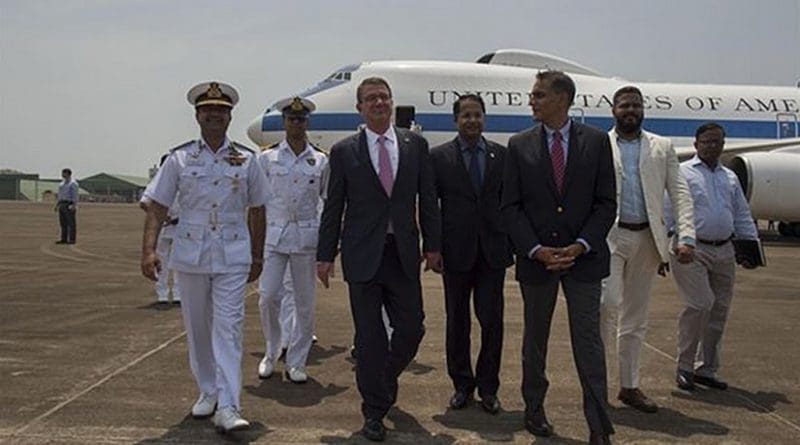Ties With US: India Needs To Think And Act Strategically – Analysis
By Observer Research Foundation
By Manoj Joshi*
Ahead of his current visit to India, US Secretary of Defense Ashton Carter spelt out the American perspective on ties with India at a meeting at the CSIS in Washington DC last week. Cutting through the hype, he said that while the US was looking for a ‘closer and stronger’ relationship with India, it was not looking for ‘anything exclusive’, beyond what emerges from the convergence of interests in the US’ pivot to Asia, and India’s Act East policy.
Actually, at this juncture, both New Delhi and the United States need some space from each other. Moves by the US to boost its ties with Pakistan through new arms packages, aimed at prodding Islamabad to get the Taliban to the negotiating table, don’t quite gel with Indo-American strategic ties. Clearly, Indian and American views are at odds here, because New Delhi is sceptical of Islamabad’s peace-making credentials and does not believe in the concept of the ‘good’ Taliban and the ‘bad’ Taliban.
The recent hyphenating of India and Pakistan on the nuclear issue, too, has not been taken kindly by New Delhi.
But Carter’s mission is to line up India to shore up a coalition to confront China in the South China Sea. Last year, during President Obama’s visit to India, the two sides adopted a Joint Strategic Vision for the Asia Pacific and the Indian Ocean.
On security issues, they affirmed “the importance of safeguarding maritime security and ensuring freedom of navigation and overflight throughout the region, especially the South China Sea.”
Clearly, the American push for joint patrolling comes from our own commitment to them. Since last December, the two sides have been discussing the joint patrolling issue to underscore their common support for the freedom of navigation of the seas.
Earlier in March, Defence Minister Manohar Parrikar appeared to play down the issue. At a press conference, Parrikar said, in something of a non–sequitur, that India was into joint exercises with the US and had not yet taken part in joint patrols — “So the issue of joint patrols at this time does not arise.”
While New Delhi may patrol wherever it wishes with the US Navy, it would have to think through the consequences of patrolling in the South China Sea carefully, because through the Nine Dash line, Beijing claims almost the entire South China Sea.
At present it is incrementally, but clearly, enhancing its military capacity there. An Indian military presence there could well result in a Sino-Pakistani riposte in the seas adjacent to India.
My view is not that New Delhi should back away at the prospect of a Sino–Pak retaliation, but that it should carefully work out its responses to the escalatory steps it may confront thereafter. It is in this context that the other elements of the Carter agenda come through — the need to press India to sign a number of foundational agreements to enable the US and Indian military to operate together effectively, especially in an operational scenario. In themselves, the agreements are not particularly onerous. Especially if you take the view that they will not tie you down, if you do not wish to be tied down. That is the big lesson India must learn from the US’ relationship with Pakistan.
As for the other key element, especially dear to Ash Carter, the Defence Trade and Technology Initiative, we need to cut through the verbiage and understand that no one, but no one, gives away technology.
For this reason, the DTTI will never quite live up to its hype. To generate defence technology, India needs to go up the long hard climb to first become part of the American/ western production and supply chains, and simultaneously provide strategic R&D funding to Indian firms, technology institutions and universities and, perhaps, see the results 20 years down the line.
One of the big gaps in the Indo–US security engagement is the lack of any significant cooperation in the Persian Gulf and the Arabian Sea. The US needs to be reminded that the Joint Vision also covers the Indian Ocean. Little or no discussion goes on here because the US military engagement with India is confined to its Pacific Command which stops mid-ocean at Diego Garcia.
Prime Minister Modi has recently taken bold steps in reaching out to the UAE and Saudi Arabia. Now he must leverage the US partnership to make deeper Indian economic and security inroads into the region, which is by far more important to us than the South China Sea.
In its ties with the US, New Delhi needs to think and act strategically.
The US’ desire to come closer to India presents a great strategic opportunity for India, and we would be criminally negligent if we did not take it. But whether it is in the area of geopolitics, or technology, India needs to have a clear-cut set of goals with five, 10 and 15 year markers to guide us along.
This commentary originally appeared in Mail Today.

